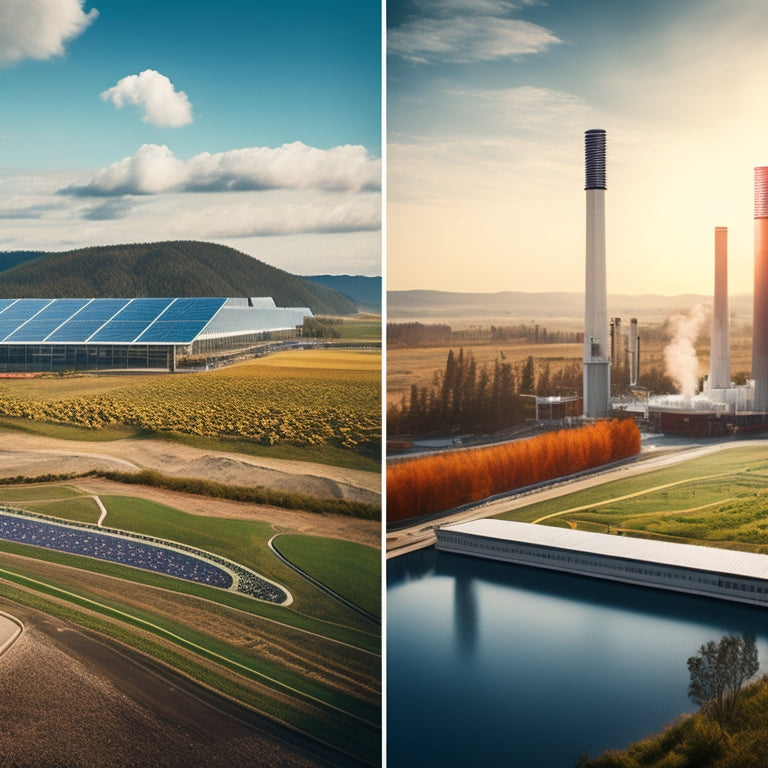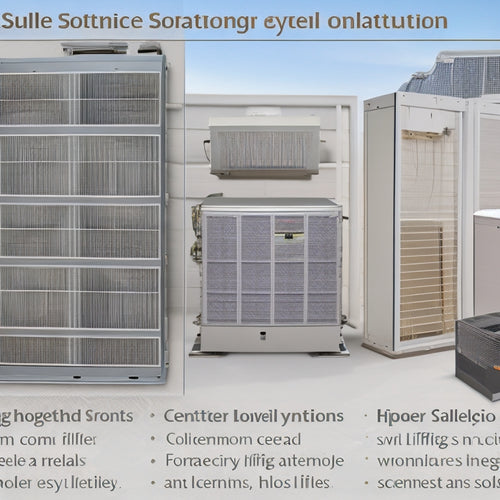
10 Best Geothermal and Solar Energy Alternatives Compared
Share
You're considering alternative energy sources and wondering which is best for you - geothermal or solar power. Both reduce your reliance on fossil fuels and offer long-term financial savings. Geothermal energy utilizes the Earth's internal heat, producing little to no emissions or waste, and is ideal for remote locations. Solar power, on the other hand, eliminates energy bills and increases property value. While installation costs vary, geothermal efficiency can reduce heating costs by 25-50%, and solar panels can last up to 30 years. Now that you've got a general idea of these eco-friendly options, investigate each system's benefits and drawbacks to determine which one suits your needs best.
Key Takeaways
- Geothermal energy systems offer reliable and sustainable energy, producing little to no greenhouse gas emissions or hazardous waste, ideal for remote locations.
- Solar power systems eliminate energy bills, increase property value, and provide long-term financial savings, with minimal maintenance due to lack of moving parts.
- Geothermal heating and cooling costs range from $10,000 to $30,000, with a lifespan exceeding 20 years, providing strong ROI and long-term savings.
- Solar panels have varying efficiency and cost, with average installation costs ranging from $15,000 to $30,000, and a typical lifespan of 25-30 years.
- Both geothermal and solar energy alternatives offer eco-friendly solutions, contributing to reduced reliance on fossil fuels and promoting sustainable living.
Geothermal Energy Systems Overview
As you investigate the domain of geothermal energy systems, you'll uncover that they tap into the Earth's internal heat to generate electricity or provide thermal energy for various applications.
These systems employ geothermal technology advancements to exploit the Earth's thermal energy, reducing reliance on fossil fuels. You'll find that geothermal energy systems have a minimal environmental impact, producing little to no greenhouse gas emissions or hazardous waste.
By integrating solar power, mitigating peak shaving can further reduce grid strain and demand charges. This clean energy source is particularly beneficial for remote or off-grid locations, providing a reliable and sustainable power supply.
Solar Power Systems Advantages
You'll find that solar power systems offer several advantages that make them an attractive option. For one, they can eliminate your energy bills altogether, saving you money in the long run.
Moreover, these systems require minimal maintenance, and they're a renewable energy source, reducing your reliance on fossil fuels.
In addition, solar-powered EV charging stations can also reduce your reliance on traditional energy sources, lowering overall carbon footprint, and can even increase property value with sustainable installations.
Zero Energy Bills
Switching to solar power can propel you into an era of zero energy bills, where your monthly savings add up quickly.
You'll enjoy energy independence, free from the shackles of fluctuating electricity prices. With solar power, you're not only reducing your carbon footprint but also embracing sustainable living, which is ideal for EV charging as it minimizes carbon footprint and enhances eco-friendliness renewable energy integration.
By utilizing solar power, you'll be decreasing your reliance on fossil fuels, which in turn lowers greenhouse gas emissions.
- Zero energy bills: No more worrying about rising electricity costs, as you'll be generating your own clean energy.
- Increased property value: Installing solar panels can elevate your property's value, making it more attractive to potential buyers.
- Government incentives: You may be eligible for tax credits, rebates, or grants for switching to solar power.
- Long-term savings: With a typical solar panel lifespan of 25 years or more, you'll reap the benefits of zero energy bills for decades to come.
Low Maintenance Costs
Harness the power of solar energy and reap the benefits of low maintenance costs. With solar power systems, you'll enjoy reduced expenses on upkeep and repairs. This is because solar panels have no moving parts, making them less prone to wear and tear. As a result, you'll save on replacement and repair costs, leading to long-term savings.
Regular maintenance, including cleaning and inspecting connections, is essential for optimal performance and longevity. Regular cleaning of solar panels can prevent up to 20% efficiency loss. Additionally, solar energy systems require minimal cleaning and inspection, further reducing maintenance expenses.
Renewable Energy Source
Solar power systems tap into a renewable energy source, utilizing the sun's energy to generate electricity.
You'll benefit from a sustainable energy solution that reduces your reliance on finite resources.
Solar power offers a clean energy source, greatly reducing greenhouse gas emissions reducing carbon footprint, and achieving energy independence minimizes reliance on the grid for a stable energy supply.
-
Abundant resource: Solar energy is available everywhere, making it a highly accessible form of renewable energy.
-
Zero emissions: Solar power systems produce no greenhouse gas emissions or pollution, contributing to a cleaner environment.
-
Energy independence: You'll generate your own electricity, reducing your dependence on the grid and enhancing your energy security.
- Long-term savings: While the initial investment may seem high, solar power systems can provide considerable long-term savings on your energy bills.
Geothermal Heating Cost Analysis
When considering geothermal heating, one of the primary factors is the cost of installation and operation.
As you weigh the benefits of geothermal energy, you'll want to understand the upfront investment required. Installation expenses can range from $10,000 to $30,000, depending on the size of your system and the complexity of the installation.
However, geothermal efficiency can lead to significant long-term savings. With a geothermal system, you can expect to reduce your heating costs by 25-50%.
Additionally, the system's lifespan can exceed 20 years, providing a strong return on investment. By crunching the numbers, you'll find that geothermal heating can be a cost-effective option for those seeking energy independence.
Solar Panels for Homes Comparison
As you investigate alternatives to geothermal energy, you're likely evaluating solar panels for your home, wondering how they stack up against traditional heating methods.
To help you make an informed decision, let's break down the key aspects of solar panels for homes.
Here are some essential factors to evaluate:
-
Solar panel types: Monocrystalline, Polycrystalline, and Thin-Film panels vary in efficiency and cost.
-
Installation costs: The average cost per watt ranges from $2.50 to $3.50, with total installation costs between $15,000 and $30,000.
-
Energy output: The amount of energy generated depends on panel efficiency, size, and local sunlight exposure.
- System longevity: Solar panels typically last 25-30 years, with some warranties extending up to 40 years.
Geothermal Cooling Systems Benefits
You'll find that geothermal cooling systems offer a highly energy-efficient operation, which translates to significant savings on your energy bills.
Additionally, these systems require minimal maintenance, resulting in lower costs over their lifespan.
Energy Efficient Operation
Geothermal cooling systems boast a significant advantage in energy efficient operation, resulting in lower energy bills and a reduced carbon footprint.
When you invest in a geothermal system, you can expect to reap the benefits of optimized energy efficiency. This is achieved through several operational strategies that minimize energy consumption.
Here are some key advantages:
-
High Coefficient of Performance (COP): Geothermal systems can achieve a COP of 4 or higher, meaning they can provide 4 units of energy for every unit of electricity used.
-
Low Energy Input: Geothermal systems require minimal electricity to operate, reducing your reliance on non-renewable energy sources.
-
No Outdoor Unit: Geothermal systems don't require an outdoor unit, eliminating the energy losses associated with traditional HVAC systems.
- Zone Control: Geothermal systems can be designed to provide zone control, allowing you to heat or cool specific areas of your home, further optimizing energy efficiency.
Low Maintenance Costs
Operating a geothermal cooling system translates to minimal maintenance worries, a benefit that strikes a chord with homeowners seeking to reduce their overall costs. You'll enjoy fewer repair bills and extended system lifespan due to the underground piping's natural protection from weathering and corrosion. This results in significant savings over time, allowing you to allocate resources to other essential areas.
| System Component | Maintenance Frequency | Average Cost |
|---|---|---|
| Ground Loops | Every 10-15 years | $500-$1,000 |
| Heat Pump Unit | Every 5-10 years | $1,000-$2,500 |
| Thermostats and Sensors | Every 2-5 years | $100-$500 |
With geothermal cooling systems, you can expect installation longevity and operational reliability, ensuring you reap the benefits of reduced maintenance costs and increased energy efficiency.
Solar Energy Storage Solutions
Utilizing solar energy's full potential requires effective storage solutions to mitigate the intermittency of this renewable power source.
As you contemplate leveraging the power of the sun, you'll need to think about how to store excess energy generated during the day for use during the night or on cloudy days.
Luckily, advancements in solar battery technology have made energy storage options more accessible and affordable. Here are some options to reflect on:
- Lead-Acid Batteries: Cost-effective and widely available, but heavier and less efficient than other options.
- Lithium-Ion Batteries: More efficient and compact, but also more expensive.
- Flow Batteries: Well-suited for long-duration energy storage, but often larger in size.
- Sodium-Ion Batteries: A newer, potentially more cost-effective alternative to lithium-ion batteries.
Geothermal Systems Installation Process
When you're considering a geothermal system, you'll need to start with a thorough site assessment to determine the thermal conductivity of the earth and the local groundwater conditions.
This assessment will inform the design of your system, which can take several forms - from open-loop systems that use groundwater directly to closed-loop systems that circulate a heat-exchange fluid.
You'll need to weigh the pros and cons of each design option to choose the one that best fits your specific needs and budget.
Site Assessment Needed
During the initial stages of geothermal system installation, you'll need to conduct a thorough site assessment to determine the viability of the project.
This site evaluation is essential in determining the land suitability for geothermal energy production.
Here are key factors to take into account during the site assessment:
-
Ground temperature: Measure the underground temperature to determine the potential heat energy available.
-
Rock formations: Identify the type of rock formations and their thermal conductivity to assess heat transfer efficiency.
-
Water availability: Determine the presence of underground water sources and their potential impact on system performance.
- Land topography: Assess the site's terrain to guarantee easy installation and maintenance of the geothermal system.
System Design Options
Across the range of geothermal system design options, you'll encounter a variety of configurations customized to specific site conditions and energy requirements.
When designing your geothermal system, you'll need to take into account factors like loop configuration, piping material, and system size. These decisions will impact system performance, so it's crucial to get them right.
For instance, a horizontal loop configuration may be suitable for smaller sites, while a vertical loop is often better suited for larger areas.
You'll also need to manage installation challenges, such as drilling and excavation, which can be complex and costly.
Solar Panel Efficiency Ratings
About 15-20% of solar panels on the market boast impressive efficiency ratings above 20%, with some premium models even reaching up to 23.6%.
As you investigate solar panel technology, you'll want to evaluate the efficiency ratings of different models. Here's what you need to know:
-
Efficiency improvements: Look for panels with high-efficiency cells, which can increase energy output by up to 10%.
-
Cell temperature: Panels with lower temperature coefficients perform better in high-heat conditions.
-
Fill factor: A higher fill factor indicates better conversion of sunlight to energy.
- Module efficiency: This measures the panel's overall efficiency, including losses due to heat and other factors.
When selecting a solar panel, prioritize models with high efficiency ratings to maximize your energy output.
Geothermal Maintenance Requirements
Your geothermal system requires regular maintenance to secure peak performance and longevity.
You'll need to schedule routine geothermal system inspections to identify potential issues before they become major problems. During these inspections, your technician will check the system's fluid levels, inspect the pipes and connections, and verify the heat pump is functioning correctly.
Additionally, consider investing in geothermal equipment upgrades to improve efficiency and reduce energy consumption. Upgrades may include replacing worn-out components or installing new technologies that optimize heat transfer.
Cost-Effective Energy Alternatives
Embracing cost-effective energy alternatives is essential in today's eco-conscious world, where reducing reliance on fossil fuels is paramount.
As you contemplate switching to geothermal or solar energy, you'll want to prioritize options that offer substantial energy savings while minimizing environmental impact.
Here are key factors to ponder:
-
Installation costs: Compare upfront investment requirements for geothermal and solar systems.
-
Energy efficiency: Assess the energy savings potential of each alternative.
-
Operating expenses: Evaluate ongoing maintenance and repair costs.
- Government incentives: Research tax credits and rebates available for eco-friendly energy solutions.
Frequently Asked Questions
Can Geothermal Energy Be Used for Water Heating and Cooking?
You can utilize geothermal energy for water heating and cooking applications, utilizing geothermal heating systems that tap into underground heat, providing a reliable, eco-friendly alternative for your daily cooking needs.
How Do Solar Panels Perform in Low-Light or Shaded Areas?
You'll find that solar panels' efficiency drops considerably in low-light or shaded areas, with energy output reducing by up to 50% in partial shade and 90% in full shade, highlighting the importance of ideal panel placement for maximum low light performance.
Are There Government Incentives for Installing Geothermal Systems?
You'll be pleased to know that, yes, you can benefit from government incentives for installing geothermal systems, including federal tax credits and state rebates, which can greatly offset the upfront costs, giving you more freedom to invest in a sustainable future.
Can Solar Energy Systems Be Installed on Old or Historic Homes?
A million bucks later, you'll still want to preserve that historic charm! Fear not, you can install solar energy systems on old or historic homes, ensuring historic preservation while maintaining solar compatibility - it's a match made in heaven!
Do Geothermal Systems Require More Maintenance Than Traditional Hvac?
You'll find that geothermal systems typically require less maintenance than traditional HVAC systems, as they have fewer moving parts, resulting in lower maintenance costs and higher geothermal efficiency, giving you more freedom from repair worries.
Related Posts
-

Why Solar HVAC Filters Revolutionize Home Energy Efficiency
By adopting solar HVAC filters, you're shifting your home's energy reliance from fossil fuels to clean, renewable sou...
-

Why Vertical Gardens Reduce Home Energy Consumption
By incorporating a vertical garden into your home design, you'll reduce energy consumption through natural insulation...
-

Why Grow Up? Vertical Gardens Transform Urban Living
As you change your urban living space, you're not just growing up - you're bringing nature back into the heart of the...


